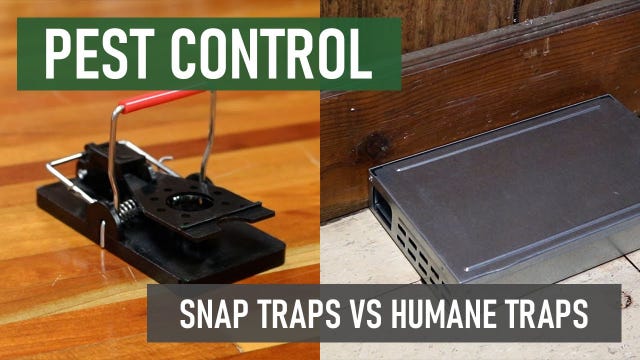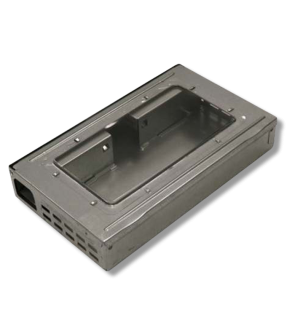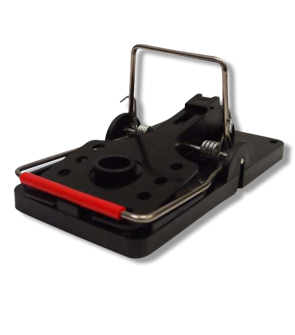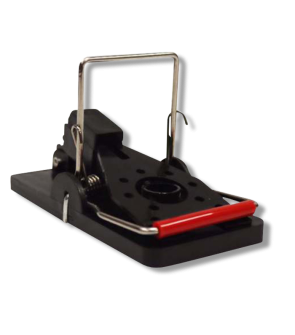Gain access to personalized product screening, the best pricing, rewards, and more!
Most Effective Products
Rodent Snap Traps Vs. Humane Mouse Traps: Which to Choose
This page is a general DIY guide for learning the differences between rat and mouse snap traps and humane mouse traps. Follow this article and use the information to better inform your decision about whether lethal or non-lethal rodent control is best for your rodent infestation.
When there is a rat or mouse infestation in your home, you want these pests gone as quickly as possible to prevent costly damages or the spread of harmful diseases. The most common solution homeowners encounter is trapping, more precisely, snap traps and humane mouse traps. Both traps can effectively control rodent infestations, but choosing between them depends on your preference.
While they both have the possibility of solving your rat or mice infestation, they also have drawbacks that are important to consider. Deciding to go with snap traps depends on a few factors, such as the level of the infestation and preference of a deceased pest. On the other hand, if you are not fond of handling a deceased rodent, then humane mouse traps may be the way to go.
This DIY guide focuses on the effectiveness of using either lethal or non-lethal rodent control products to assist homeowners in rat or mice infestations.
What is a Rat/Mouse Snap Trap

Snap traps are the most traditional form of rat or mice control within homes, businesses, or other structures. They are still widely used today by most professionals and homeowners simply because they work and they work fast.
It is a specific type of lethal rodent trap designed to be placed in rat and mouse walkways. The rat or mouse moves to retrieve the bait lying on the trigger plate, which the spring is attached to. The rodent is then killed or fatally injured when pressure is placed on the trigger plate, causing the strike bar to snap shut on the rodent.
To eliminate rodent infestations in or around your home quickly and effectively, we recommend using Solutions Easy Set Rat Trap or Solutions Easy Set Mouse Trap. Both of these products are designed after a traditional snap trap design.
The Easy Set Snap Traps are a type of lethal rodent snap trap made from durable plastic and steel, making them more long-lasting than traditional wooden snap traps. With its unique construction, the Solutions Easy Set Traps provides excellent economic value with its ability to be reusable.
Unlike traditional wooden rodent snap traps, the Solutions Easy Traps are designed at a 90-degree angle to decrease the distance the strike bar needs to catch the rat or mouse. This significantly increases the snap trap's success and offers a quick, humane kill with easy clean-up afterward.
What is a Multiple-Catch or Live-Catch Mouse Trap

Humane traps, also known as no-kill or catch-and-release mouse traps, are rodent control products that allow you to capture multiple rodents in and around your home, garage, or other structure without harm. Unlike snap traps, these products work by allowing you to transport the captured rodents and release them safely to somewhere far away from your property.
Most multiple-catch mouse traps are successful because rodents seek a protected travel pathway to limit their exposure to possible predators in their environment. Upon entering its environment, the mouse will perceive a hole in the trap as an opportunity to hide or create a nesting site in the holes. Most individuals refer to this behavior as curiosity, thus leading to multiple-catch traps as "curiosity traps."
If you want to control a mouse infestation with humane products, we recommend the Solutions Multi-Catch Humane Mouse Trap. This low-profile metal trap can capture 30 live mice at a time and release them with little handlement. Once the mice step far enough into the product's entrance hole, the door will automatically close behind it, ensuring total capture without toxic chemicals and harm to the pest.
Difference Between A Rat and Mouse
Before you start any pest control plan, you must make sure the pest is actually a rat or mouse. Careless identification can lead to using the wrong control methods and products, which can be a waste of your time and finances.
The easiest way to tell between a rat and a mouse is to look at their excrement and the size of the pest itself. Rats are nearly double the length of house mice, with the Norway rat being the largest and the roof rat second.
House Mice: Droppings of house mice are less than a quarter inch and are shaped like a grain of rice. Including the tail, house mice are about 4 inches and fit in openings as small as a dime.
Norway Rat: Norway rat droppings have blunt ends and measure about 3/4 inches in length with blunt ends. Not including the tail, Norway rats measure up to 16 inches in length and have tails about 8 inches in length. They can fit in openings as small as a quarter.
Roof Rat: Waste of roof rats have pointed ends and measure up to 1/2 inches in length. Roof rats are about 8 inches in length, with tails measuring between 7 to 10 inches. Like the Norway rat, the roof rat can fit in openings as small as a quarter.
To learn more about the differences between rats and mice, check out our DIY guide Rats Vs. Mice.
Is It Better to Use Snap Traps or Live Traps for Rodents?
Whether using lethal or non-lethal means, it is best to control rodent infestations humanely to prevent unnecessary suffering for the pest. Before you choose a lethal or non-lethal rodent control trap, you should consider the advantages and disadvantages of each.
Either of these products can be used, but keep in mind that you will need to use multiple products to completely get rid of the rats and mice. For a demonstration of captured rodents, refer to the image above. In the left a fake rodent is caught in the snap trap and on the right a mouse is caught in a humane trap.
Advantages of Snap Traps
- Death of a rat or mouse can be very rapid.
- Traps like the Solutions Easy Set Rat Trap and Solutions Easy Set Mouse Trap can be reused, providing economic value.
- Rats and mice can be removed quickly and easily. Snap traps eliminate the possibility of a rodent perishing in out-of-reach areas like the walls.
- No chemical usage allows a safer form of rodent control within indoor and outdoor areas.
Disadvantages of Snap Traps
- They must be placed in out-of-reach areas for children and pets to avoid injury. However, snap traps like the Easy Set Rat Trap can be placed in a tamper-proof bait station in outdoor areas to control rodents and protect your children and pets while they are exploring.
- You must check the snap trap daily to rebait or reset it each time a rodent is caught. Otherwise, rodents may become wary of the trap when they smell or observe a deceased pest.
- You can only catch 1 rat or mouse at a time. For this reason, you will need to spread multiple snap traps around the infested area to control large infestations completely. You will also need to remember that rodents will have multiple exits and entrances to their nests, so it would be best to use multiple snap traps.
Advantages of Live Capture Traps
- A rat or mouse is caught without harm and kept alive inside the trap until it is ready to be released.
- Easy to transport: Most live capture traps, such as the Multi-Catch Humane Mouse Trap, are easy to carry and come ready to be used. This allows the trap to be implemented quickly and transported safely with the rodent after capture.
- There is no chemical usage, and it has enough space for the rodent to move around until you release it.
Disadvantages of Live Capture Traps
- It must be checked daily, as a captured rodent can perish from dehydration, heat stress, or starvation.
- Once a rodent is caught in the humane trap, dealing with the live pest becomes your responsibility.
- Unlike snap traps, multiple-catch rodent traps are not helpful against rats. Not many live capture traps are designed for rats, but more for mice. Rats are large pests, so holding large amounts of them can be difficult. Unlike mice, which are small in size and more curious in nature, rats are more cautious and will avoid a trap altogether.
- While most live capture traps can hold 15 to 30 mice, they are not suitable for large rat or mouse infestations. They are, however, ideal for small rodent infestations or monitoring practices.
How to Use Snap Traps or Live Traps for Rodents
Since rodents are very cautious, you will need to wear the proper personal protective equipment (PPE), such as gloves, to mask your scent from the pest.
Remember that a snap trap like the Solutions Easy Set Rat Trap or Solutions Easy Set Mouse Trap will eliminate the rodent, but a live capture trap like the Multi-Catch Humane Mouse Trap contains the mice without harm until they are ready to be released. However, if rodents are left in the live capture trap for long periods of time, they can perish.
Step 1: Bait the Trap
We recommend using baits such as peanut butter because they are easy to apply, cannot easily be removed from the trap, and have a strong scent that attracts mice and rats. For either trap, apply the peanut butter with a utensil, like a spoon or a knife, to avoid leaving any trace of your scent.
Smear the peanut butter on the trap platform or trigger plate of the snap trap, or in this case, the Solutions Easy Set Trap reservoir. Avoid placing a glob of bait, as this will be too easy for the rodent to get without springing the snap trap.
In live capture traps, place the bait as labeled per the product label instructions. For the multi-catch humane mouse traps, you will need to place the bait within the trap near the end of the tunnel and in front of the vent openings. This will ensure that mice smell the scent of the bait, thus making it more likely for them to enter the trap.
To increase the success of your snap trap, it's recommended to set the un-set, baited trap in the rodents' common pathway of travel for at least two days in the same spot. Rodents are cautious pests and will avoid the trap for some time, but with a fresh supply of bait on a daily basis, they will be more likely to approach it. After the third day, the snap trap can be set.
Step 2: Place the Trap
When ready to use the Solutions Easy Rat Trap, you will pull the upright bar slowly until it is locked in place. Indoors, place the Solutions Easy Set Trap 10 to 15 feet apart, with the reservoir or baited end towards the wall.
Outdoors, set the Solutions Easy Set Trap 15 to 20 feet apart in the rodent pathways and areas where it frequents, such as along fence lines, under or near shrubs, and along walls. When used outdoors, we recommend placing the Solutions Easy Set Trap inside of a tamper-proof bait station like the Solutions Rat and Mouse Bait Station. This is because rodents prefer dark and enclosed spaces, but it will also protect scavenging wildlife, pets, and children.
To set a multiple-catch mouse trap like the Multi-Catch Humane Mouse Trap, open the trap's lid and set the bait as mentioned previously. Once done, close the trap's lid and place it in places where you have seen mouse activity. Set the Trap flat against a wall or fence line, with the entry tunnels closer to the structure, to ensure it is directly in the mice's travel pathway.
Check both of these traps daily and re-bait until rodent activity is no longer witnessed. Properly dispose of the deceased pest for the snap traps.
Once you catch a mouse in your live capture trap, release it as soon as possible. It's recommended that you release the mice 2 or more miles away from your property. You may also want to contact your local animal control to ensure you properly relocate the mice.
Key Takeaways
Which Type of Trap is Best for Rats and Mice?
- Both snap traps and humane mouse traps (no-kill or catch-and-release mouse traps) have advantages and disadvantages. A humane trap is best for trapping small levels of a rodent infestation, whereas a snap trap is best for removing large amounts of rodents.
Do Mice Return After Being Released
- A mouse will return if released not too far from its original infestation site. It's best to release the mouse at least 2 miles from your home and the site it was previously captured from.
What Kills Rats and Mice Instantly?
- Snap traps are a fast method to eliminate rats and mice in and around your home or property without poisons.













